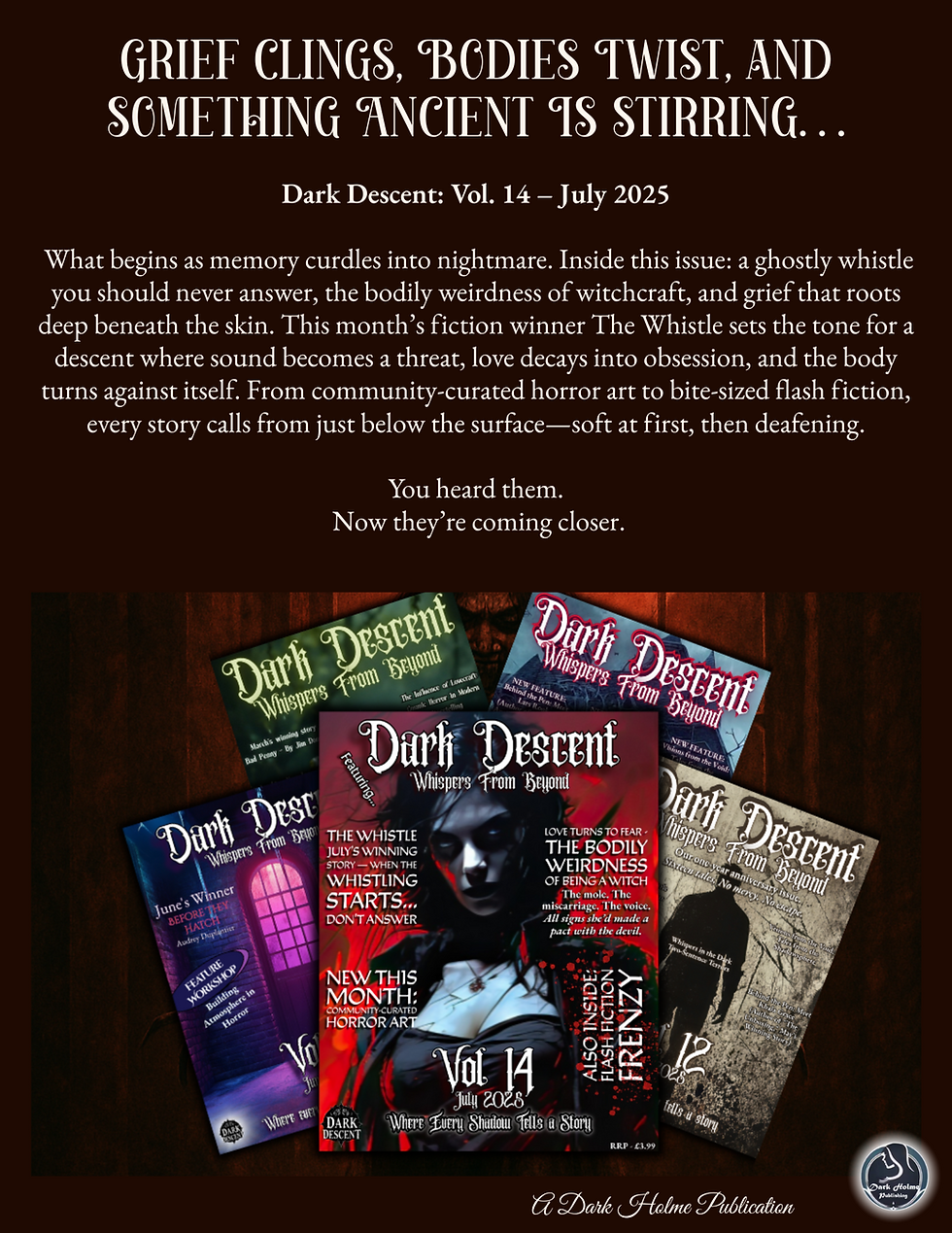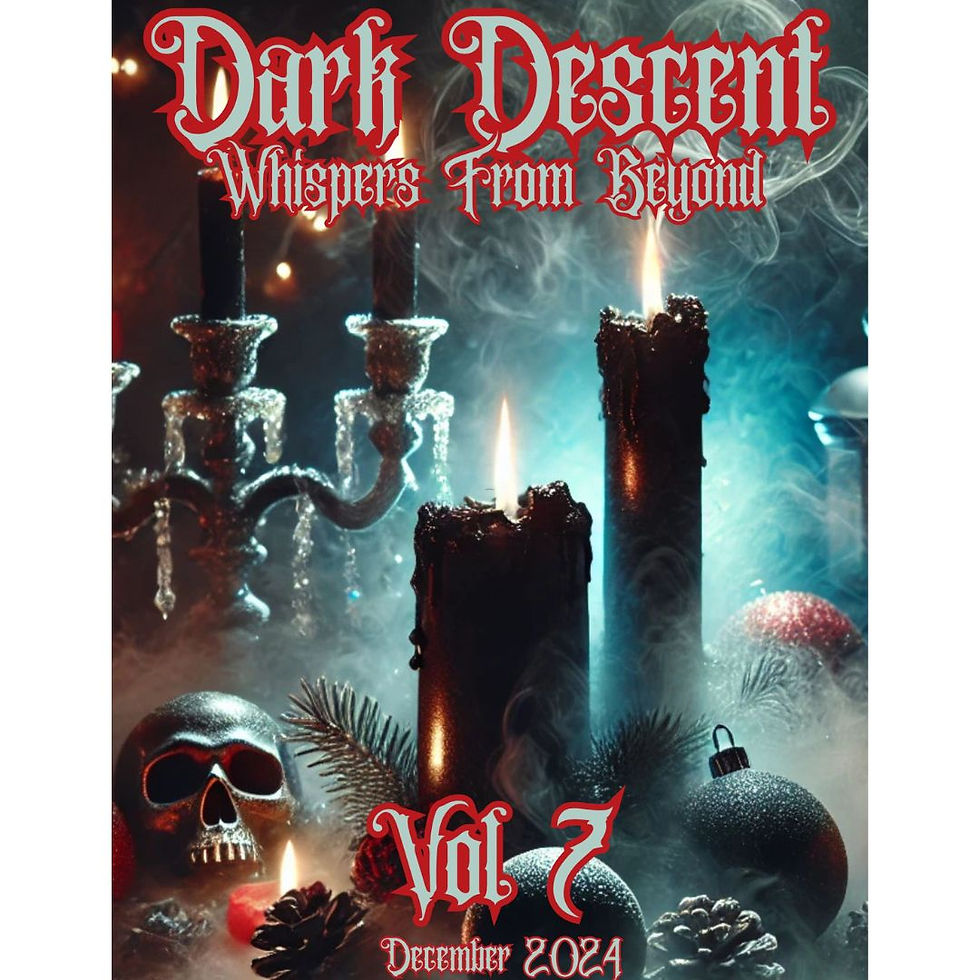Indie Horror and the Power of Short Stories: Amplifying the Voices That Need to Be Heard
- darkholmepublishing

- Mar 6
- 5 min read
Horror has always thrived on the margins. From gothic folklore whispered in the dark to pulp magazine terror tales, the genre has long been an outlet for confronting the things society fears most. But who gets to tell those stories—and what fears they choose to highlight—has historically been limited by the industry’s gatekeepers.
Enter indie horror and the resurgence of short fiction—a medium that is not only breathing new life into the genre but also challenging racism, transphobia, and misogyny in ways mainstream horror often fails to. In the world of indie horror, marginalized voices are finally getting the space they deserve, and these stories are more relevant than ever.
The Unique Power of Short Horror Stories
Short fiction has always been at the heart of horror’s evolution. Unlike novels or films, short stories allow writers to take risks, explore themes mainstream horror avoids, and deliver sharp, unsettling narratives without worrying about mass-market appeal. In short fiction, there’s no time to waste. The writer must go straight for the jugular, delivering a punch that stays with the reader long after the story ends.
1. Short Horror Stories Cut Straight to the Fear
There’s no time for filler in short fiction. A novel can spend pages building tension, but a short horror story has to strike immediately. It can’t afford to waste words on unnecessary subplots. It has to be concise, focused, and intentional. That makes it the perfect format for tackling uncomfortable truths.
Take Ally Wilkes’ unsettling cosmic horror, which explores themes of colonialism and exploitation. In a few pages, Wilkes captures the terrifying reality of what it means to be othered by society, showing how monsters are often born from human cruelty. Or consider P. Djèlí Clark, whose short stories weave together elements of horror, historical fiction, and fantasy to confront the real-world horrors of racism and power structures. In both cases, short fiction allows these authors to deliver gut-punching horror in a matter of pages, leaving readers haunted long after the last word.
2. Indie Horror Creates Space for Marginalized Voices
Mainstream horror has a long history of erasing or misrepresenting marginalized people. Whether it’s Black characters being the first to die, queer characters being painted as monsters or predators, or Indigenous and non-Western folklore being appropriated without understanding, mainstream horror often fails to represent real-life fears. Indie horror, however, is carving out a space where these voices can flourish.
Indie horror fights back by giving those very voices the platform to tell their own stories—authentically, unapologetically, and without the need for approval from corporate publishers. No longer relegated to the sidelines, marginalized authors are using the indie scene to reshape the genre and give voice to their unique experiences.
Consider Cassandra Khaw, whose short stories bring queer and trans horror to the forefront. Khaw’s works are not just about monsters and gore; they are deeply personal, exploring themes of identity, love, and the psychological terror of being seen as “other.” Similarly, Hailey Piper brings queer horror to the forefront with narratives that defy traditional tropes and create deeply empathetic, terrifying worlds that center marginalized voices.
Other authors, like Tananarive Due and Stephen Graham Jones, craft horror that dives into racial trauma and the realities of systemic oppression, reshaping the genre from within. Through these writers, indie horror is demonstrating how the genre can reflect the lived experiences of those whose stories have been ignored for far too long. These are the kinds of stories mainstream horror has ignored or underrepresented, but indie horror is ensuring they cannot be dismissed anymore.
3. Horror as a Weapon Against Real-World Fears
The best horror stories aren’t just scary—they say something. Horror, at its best, has always been a tool for social commentary, pushing boundaries and forcing society to confront uncomfortable truths. Even the most terrifying monsters often serve as a reflection of real-world fears. Historically, horror has critiqued everything from colonialism to gender roles, from class disparity to state-sponsored violence.
Consider Night of the Living Dead (1968), which was a scathing critique of racism and the political climate of the 1960s. The zombie apocalypse in this film wasn’t just a backdrop for scares—it was a commentary on the breakdown of society and the marginalization of Black Americans. Similarly, The Babadook (2014) explored grief and mental illness, showing how trauma manifests itself as a monstrous, inescapable presence in our lives. Get Out (2017) exposed the horror of white liberalism and the everyday racism Black people face, turning the most banal of settings—a dinner party—into a place of terror.
Indie horror short stories take this even further by diving into specific, modern fears that often get overlooked in mainstream horror. These stories confront:
Transphobia, with narratives like Boys, Beasts & Men by Sam J. Miller, where the characters’ fears of erasure and identity struggle take on monstrous forms.
Black horror that tackles systemic oppression and explores what happens when marginalized communities confront their worst fears in The Devil in America by Kai Ashante Wilson.
Indigenous horror that reclaims lost history and stolen myths, like in Mapping the Interior by Stephen Graham Jones. These stories not only deliver suspense and terror, but they also force readers to confront prejudice, violence, and historical erasure.
These stories aren’t just entertainment. They force readers to confront real horrors—and in doing so, they present horror in its most potent form: a weapon against the status quo.
Indie Horror: The Future of the Genre
The horror landscape is shifting. While major publishers and studios still push the same familiar narratives, indie horror is thriving because readers want something different.
They want horror that feels real, horror that reflects their fears, and horror that doesn’t just rely on cheap jump scares or shock value, but lingers in the mind long after the lights are turned back on. Short fiction is leading the charge because it allows new voices to bypass the traditional gatekeepers—publishers, studios, and media conglomerates—and deliver their work directly to readers. With platforms like indie anthologies, digital magazines, Patreon, and self-publishing, horror writers don’t need permission to tell their stories anymore.
Indie horror offers a space for writers to experiment, explore taboo subjects, and innovate with new narratives. It’s not beholden to commercial success—it’s fueled by passion, creativity, and the desire to create meaningful art. And that’s what makes indie horror terrifying—to the mainstream industry at least. It can’t be controlled, watered down, or forced into a marketable mold. It’s raw, it’s real, and it’s exactly what horror has always been meant to be: a force for social change.
Final Thoughts: Horror That Truly Scares Us
Horror has always been a weapon—one that reveals the darkest parts of society, forces us to confront our fears, and gives a voice to those who have been silenced. Short horror fiction, fueled by the indie horror movement, is keeping that tradition alive.
The most chilling monsters are not the ones lurking in the shadows, but the ones that reflect our collective nightmares. Whether it’s the fear of not being able to express who we truly are, the terror of living in a world where we are denied justice, or the haunting legacy of systems built on oppression, indie horror short stories are giving voice to the marginalized. These writers aren’t just creating monsters—they’re creating spaces where we can confront our deepest fears.
So the next time you read a horror story that truly unsettles you, ask yourself: Was it the monster? Or was it the truth hiding behind it?
Let’s discuss—what indie horror stories have left a lasting impression on you? Whose voices do you think need to be heard more in the genre?
.png)

1.png)



































Comentários